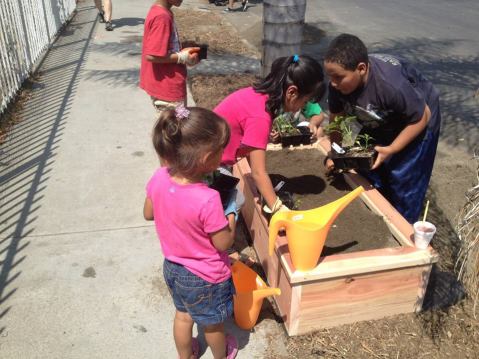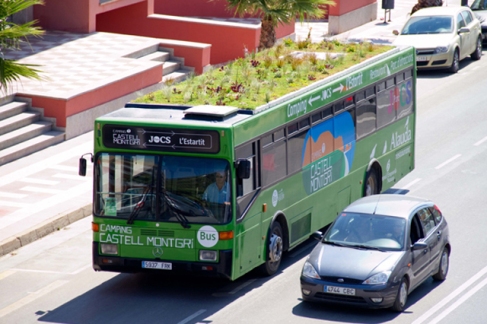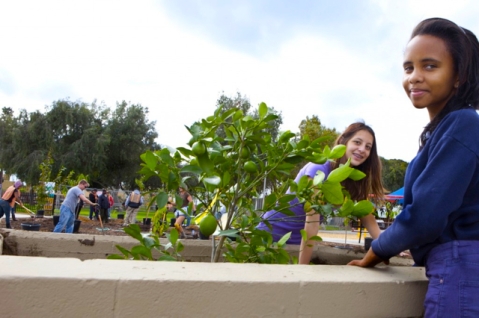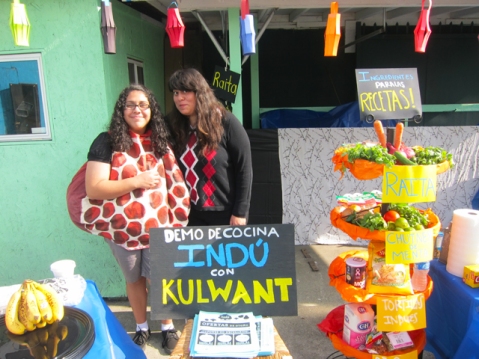LA Waves Parkway Planting Permits to Create Opportunities in Food Deserts
In my last post, I highlighted an innovative program in Toronto which brings a mobile produce market to communities who lack access to affordable and healthy food. In an effort to address healthy food access in similarly underserved neighborhoods across the US, some community residents have literally taken action into their own hands by transforming underutilized and sometimes unlikely patches of land into “guerrilla” gardens.
Trees, wildflowers, herbs, fruits and vegetables pop up in vacant lots, alleys, tree pits and even parkways (the planted strip of land between the curb and the sidewalk), providing aesthetic value, helping to oxygenated the air and clean the soil, as well as providing families with an opportunity for healthy eating. Parkways are often owned by a city but the responsibility for maintenance falls on the adjacent homeowner. These spaces have a lot of potential for urban gardening because they are right outside of a house or apartment building and are a manageable size. Some parkways go ignored, some become planted, and others become community resources.
In 2010, gardener and activist Ron Finley co-founded LA Green Grounds, a group who plants and tends gardens created in parkways and other underutilized spaces with the hope of creating a food and health revolution in underserved South Los Angeles. In 2013, Mr. Finely gave a TED Talk (above) where he discussed the inspiration for the parkway garden he created in front of his home. Mr. Finley, who grew up in South Los Angeles and raised his children there, asked the audience, “…I was wondering, how would you feel if you had no access to healthy food, if every time you walk out your door you see the ill effects that the present food system has on your neighborhood? I see wheelchairs bought and sold like used cars. I see dialysis centers popping up like Starbucks. And I figured, this has to stop. So I figured that the problem is the solution. Food is the problem and food is the solution. Plus I got tired of driving 45 minutes round trip to get an apple that wasn’t impregnated with pesticides.”
Prior to a 2013 amendment to the City’s “Residential Parkway Landscaping Guidelines”, it was illegal to plant fruits and vegetables in parkways, but due to the activism of Mr. Finley and many others, the LA City Council decided to make an exception for vegetable gardening. While this news was a step in the right direction for urban gardeners and community health advocates, the permit to plant anything other than grasses and certain shrubs, still carried a cost-prohibitive $400 price tag. But just this week, the LA City Council voted to waive the $400 fee for parkway gardens (excluding fruit trees). The City Council will still have to define the parameters of the law (regulating garden height and addressing concerns such as safe passage for pedestrians) and the ordinance will be subject to final Mayoral approval, but waiving the fee will be a significant win for advocates and paves the way to increase the opportunity for residents to bring fruits and vegetables in to their neighborhoods without the worry of fines hanging over their heads.
My Finley says: “I have witnessed my garden become a tool for the education, a tool for the transformation of my neighborhood. To change the community, you have to change the composition of the soil. We are the soil. You’d be surprised how kids are affected by this. Gardening is the most therapeutic and defiant act you can do, especially in the inner city. Plus you get strawberries.”
Toronto’s Mobile Market
The Mobile Good Food Market is taking healthy food on the road and providing affordable and nutritious food options in communities that live in food deserts – neighborhoods with little local access to healthy food options.
The bus was the brainchild of FoodShare Toronto which is an organization who works with neighborhoods and schools to provide healthy food options and education. They operate under the notion that “everyone deserves access to affordable high-quality fresh food”.
The bus was designed by LGA Architectural Partners and commissioned by FoodShare Toronto. The wheelchair accessible bus can be boarded to check out the goods and can also protect patrons in inclement weather.
Currently, the bus travels to neighborhoods only two days a week but FoodShare Toronto is hoping to find funding to expand service and provide more opportunities for residents to take advantage of healthy, fresh foods.
This program reminds me of Boston’s City Hall To Go truck which brings city hall services right to your front door. The mobile office travels to different neighborhoods and allows constituents to renew a residential parking permit, get something notarized, request a copy of a birth certificate and more. This service provides easy access to documents and services that may be difficult to obtain because of personal mobility, distance or other issues. It’s exciting to think about what others ways our cities, towns or even rural communities could be transformed through other kinds of mobile services.
Your Garden Variety Bus
Designer Marc Granen decided to plant a garden on the roof of a bus. Yes, a bus.
If you’re in Spain, you might be able to catch a glimpse of the Phyto Kinetic in action. Granen and his team of designers have designed a lightweight rooftop garden with a multitude of uses. Granen says that his mission “is to expand the garden area in urban environments, increase the absorption of CO2 and give public transport a new ecological and tourist attraction”.
I appreciate Granen’s clever use of a space that we may not think of as underutilized and I think it would be exciting if these buses were able to help grow and deliver food to neighborhoods that have poor access to healthy food options. Maybe they could grow gardens on school buses and that food could feed the children!
Some buses have bicycle racks but front racks add space when the bus is parked and areas that have limited space (i.e. Manhattan) cannot afford the extra room. Utilizing the top of the bus, could provide a resource and not have to take up additional space.
An Edible Orchard in Los Angeles
On Saturday, January 5th, a revamped Del Aire Park in Los Angeles’ South Bay was revealed to its neighbors. The new park received $4 million dollars in upgrades to its community center, basketball court, and baseball field and in addition to these upgrades, a grant was secured through the Los Angeles County Arts Commission Civic Art Program to plant 27 fruit trees at the park and an additional 60 fruit trees around the neighborhood.
The fruit park (the first of its kind in the state) was created in collaboration with The Office of Supervisor Mark Ridley-Thomas and the Los Angeles County Department of Parks and Recreation and planted by artist collective Fallen Fruit, a group that invites “the citizens of Los Angeles to reconsider their relationship with public and urban space to explore the meaning of community through sharing and creating new and abundant resources.”
At the opening of the park, Supervisor Mark Ridley-Thomas said that “Community gardens and farmers markets are truly the town centers of our communities,” and they become spaces where the community gets to know one another. These kinds of resources can also be incredible important in neighborhoods that do not have easy access to healthy foods.
Over time, the fruit trees in the park and around the neighborhood will grow and give the community plums, pomegranates, peaches, limes, avocados, and apricots, as well as grapes and edible herbs. A wooden sign by the orchard reads: “The fruit trees in this park belong to the public. They’re for everyone, including you. Please take care of the fruit trees and when the fruit is ripe, taste it and share it with others.”
East LA’s Fresh Food Advocates
Some of us are lucky enough to live in a neighborhood where we can find fresh fruits and vegetables and other healthy food options within a short car ride or walking distance from our homes. For those who live in a “food desert” (and especially those who do not have a car or access to reliable public transportation) the options are usually limited to fast food restaurants, street food, 99 cent stores, liquor stores and inadequate local corner markets; and options can have a huge impact on a neighborhood’s health.
Local East Los Angeles resident, Clara Mejia understands what it’s like to live in a food desert. “In East L.A. it’s cheaper and easier to buy four fast food hamburgers than to cook a healthy meal at home,” she said. “There just aren’t many options for healthy food here.” Clara describes a food desert as “a place that has a lack of access to healthy produce and mainstream grocery stores”. East Los Angeles residents have suffered from the lack of accessible food options in their community by having some of the high rates of obesity, heart disease, hypertension and stroke in Los Angeles County.
Clara and her classmates at East L.A. Renaissance Academy (ELARA), School of Urban Planning and Design are learning how to change this paradigm by thinking critically about food justice and how to an active agent of change their community. In 2010, ELARA partnered with Public Matters (LINK) and the UCLA-USC Center for Population Health and Health Disparities to increase access and consumption of healthy foods among Latino’s in East L.A by transforming four corner stores into venues with healthier food options.The program called “Proyecto MercadoFresco del Este de Los Angeles” is part of a five-year long initiative tilted “Family and Neighborhood Interventions to Reduce Heart Disease Risk in East L.A.”
ELARA students have been working with Public Matters to learn about the negative impact of food deserts on public health and how to use social marketing, media (check out their amazing video below!) and community engagement to become advocates for healthy food options. Last Summer, Clara and her classmates helped to transform Yash la Casa Corner Market with facade treatments, refrigeration upgrades, a community garden and multi-cultural cooking classes demonstrating affordable meals options. Clara says: “After we started the project, Kulwant, the store owner, asked if we could build a garden. A total of 26 students broke the concrete in the back of the store, brought in soil and plants, and painted the walls with stencils and silhouettes of fruits and vegetables”. The transformation of the market really became a community event and helped bring those involved closer together around these issues.
When she began her classes with Public Matters, Clara she had no idea how transformative the classes would be. “We even planted our own garden at home, including apples, peaches, tomatoes, beets, carrots, lettuce, squash, broccoli, and zucchini.” As Clara points out, the root of the issue is about having access: “People in East L.A. would eat healthier if they had options for buying healthy food.”
Have You Noticed How Often You Eat Fast Food? from Public Matters on Vimeo.










